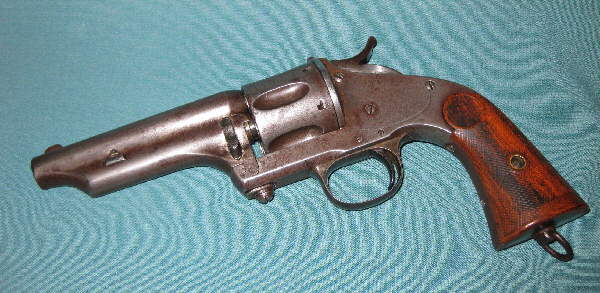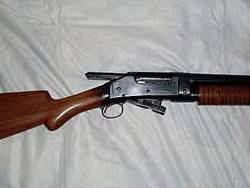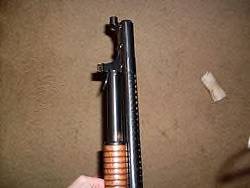| From Ethan Cord,
Cliff Hanger,
I wish it was more but this sudden news coupled with a
deadline, well my apologies to you and Red Sun. Here are some rambling
thoughts for the Gazette;
I believe the first time I met Red Sun was at one of Bill
and Dorothy Hahn’s annual matches at the old Lake Elsinore Gun Club range.
That was in May of 1990 and it was the first of many Cowboy Action Shooting
matches that I had the pleasure of shooting with Red Sun at. For a few
years Red Sun ran a monthly match at the Rainbow Gun Club in North San
Diego county. This event was usually small and followed the early style
of Cowboy Action Shooting mostly using one handgun. As SASS membership
grew and the game changed there were a few stalwart folks like Red Sun
and the Hahn’s that preferred to run matches with one handgun and keep
the shooting styles very traditional. I believe the Old West Shooting Association
(OWSA) with folks like Red Sun was the driving force behind keeping the
game very traditional while providing world class props and artwork coupled
with shooting scenarios that were just plain fun!
Red Sun ran many great annual matches like Frontier Days
starting at the Pala shooting range, moving to Cajon and finally arriving
at the Double R Bar. Red Sun dressed in great cowboy gear and was always
smiling when he was on the range. He embodied the “Spirit of the Game.”
He enjoyed doing things the old ways, such as loading his shot shells with
antique hand tools and roll crimpers. Red Sun and I shared a love of the
old original guns and we both enjoyed the challenge of getting one of the
old smoke wagons back into the game, be it by a little gun tinkering or
forming brass and finding components for obsolete calibers. Red Sun was
inspirational to myself and others when it came to traditional firearms
and calibers and of course shooting them with real black powder. He was
always eager to share helpful hints to anyone who would ask for his guidance.
We have lost another friend and guiding force in Cowboy Action Shooting.
Even when he knew he did not have much time left here he was still actively
pursuing his Frontier dreams! In closing I will share one of the recent
emails I received from Red Sun in reply to one of mine talking about one
of our favorite subjects; old cowboy guns:
“Hey Ethan,
Good hearing from you. The Doctors are doing just
about all they can. I've been dabbling in gunsmithing chores around the
house. So I'm staying busy and the old Frontier guns have not lost their
luster in my eyes. This sounds ridiculous, but I am still buying
guns! Ol' well, old habits die hard.
The No. 3 Smith sounds cool. My plan was to shoot
that match with a Merwin Hulbert open top in 44-40 and either my Marlin
in 38-55 or a 1876 in 45-60. I love these guns. Well, I am getting stronger
and hopefully in time, I'll be able to get to a match.
Stay in touch and say hi to your dad for me,
Red Sun”
Via Con Dios old friend!
Ethan Cord
| Here is a picture of the Merwin Hulbert Red Sun sent
to me if you can use it in the article: |
 |
|
| More on the Winchester Model 1897 from
Wikipedia
The Winchester Model 1897, also
known as the Trench Gun, Model 97 and M97, was a pump-action shotgun with
an external hammer and tube magazine manufactured by the Winchester Repeating
Arms Company. The Model 1897 was an evolution of the Winchester Model 1893
designed by John Browning. From 1897 until 1957, over one million of these
shotguns were produced. The Model 1897 was offered in numerous barrel lengths
and grades, chambered in 12 and 16 gauge, and as a solid frame or takedown.
The 16-gauge guns had a standard barrel length of 28 inches, while 12-gauge
guns were furnished with 30-inch length barrels. Special length barrels
could be ordered in lengths as short as 20 inches, and as long as 36 inches.
Since the time the Model 1897 was first manufactured it has been used by
American soldiers, police departments and hunters.
History
The Winchester Model 1897 was designed
by the famous American firearms inventor John Moses Browning. The Model
1897 was first listed for sale in the November 1897 Winchester catalog
as a 12 gauge solid frame. However, the 12 gauge takedown was added in
October 1898, and the 16 gauge takedown in February 1900. Originally produced
as a tougher, stronger and more improved version of the Winchester 1893,
itself a takeoff on the early Spencer pump gun, the 1897 was identical
to its forerunner, except that the receiver was thicker and allowed for
use of smokeless powder shells, which were not common at the time. The
1897 introduced a "take down" design, where the barrel could be taken off;
a standard in pump shotguns made today, like the Remington 870. Over time,
“the model 97 became the most popular shotgun on the American market and
established a standard of performance by which other kinds and makes of
shotguns were judged, including the most expensive imported articles”.
The Winchester Model 1897 was in production from 1897 until 1957. It was
in this time frame that the "modern" hammerless designs became common,
like the Winchester Model 1912 and the Remington 870 and the Model 1897
was superseded by the Winchester Model 1912. However, the gun can still
be found today in regular use.
Improvements From the 1893
In the new Model 1897, many of the
weaknesses that were present in the Model 93 were taken into account and
remedied. These improvements included:
* The frame was
strengthened and made longer to handle a 12 gauge 2¾-inch shell,
as well as the 2?-inch shell.
* The frame
at the top was covered so that the ejection of the fired shell was entirely
from the side. This added a great amount of
strength to the frame of the gun and it allowed the use of a 2¾
inch shell without the danger of the gun constantly jamming.
* The gun could
not be opened until a slight forward movement of the slide handle released
the action slide lock. In firing, the recoil of the
gun gave a slight forward motion to the slide handle and released the action
slide lock which enabled immediate opening of the gun. In the
absence of any recoil, the slide handle had to be pushed forward manually
in order to release the action slide lock.
* A movable
cartridge guide was placed on the right side of the carrier block to prevent
the escape of the shell when the gun was turned
sideways in the act of loading.
* The stock
was made longer and with less drop.
Of the improvements, the slide lock
is the one that really made the gun safer. This improved slide lock kept
the gun locked until actual firing occurred which prevented the gun from
jamming in the case of a misfire. The slide lock "stands in such a relation
to the body of the firing pin as will prevent the firing pin reaching the
primer until the pin has moved forward a sufficient distance to insure
locking of the breech bolt." This prevents the action sleeve "from being
retracted by the hand of the gunner until after firing, and hence rendering
the fire arm more safe"
Description
 . .
Open action on an 1897 portraying the long
slide that projects from the receiver. |
The Winchester Model 1897 evolved
from the Winchester Model 1893. The Model 1897 and 1893 were both designed
by John Browning. The Model 1897 is an external hammer shotgun lacking
a trigger disconnector giving it the ability to slam fire. This means that
the user can hold the trigger down while pumping the shotgun and once the
pump is returned to the forward position the gun fires. The gun itself
is classified as a slide action pump shotgun. It was the first truly successful
pump-action shotgun produced. Throughout the time period the Model 1897
was in production, over a million of the type were produced in various
grades and barrel lengths. 16-gauge guns had a standard barrel length of
28 inches, while 12-gauge guns were furnished with 30-inch length barrels.
Special length barrels could be ordered in lengths as short as 20 inches,
and as long as 36 inches. Along with various grades and barrel lengths,
the Model 1897 came in two different chamberings. One was the 12 gauge
and the other was the 16 gauge. The shells should be of the 2-¾
inch or 2-? inch model. Any shells larger are not recommended. An average
Model 1897 held 5 shotgun shells in the magazine tube. After including
the one shell that could be held in the chamber, the average Model 1897
held a total of 6 shotgun shells. However, this would vary from grade to
grade. When working the action |
of the Model 1897 the fore end
is racked and a long slide comes out of the receiver and ejects the spent
shell while simultaneously cocking the external hammer. This is why the
gun is classified as a slide action pump shotgun.
The Chinese company Norinco has
made an effort to reproduce this firearm. The Norinco 97 is an almost exact
copy of the Winchester 1897, produced in both Trench and Riot grades, yet
lacking in the fit and finish of the originals.
Grades of the Model 97
| Different Grades of the Model 1897 |
| Grade |
Gauge |
Barrel (Inches) |
Production Dates |
Remarks |
| Standard |
12, 16 |
30, 28 |
1987 - 1957 |
Plain walnut stock with steel butplate |
| Trap |
12, 16 |
30, 28 |
1987 - 1931 |
Fancy walnut with checkering |
| Pigeon |
12, 16 |
28 |
1897 - 1939 |
Same as Trap, but hand engraved receiver |
| Tournament |
12, 16 |
30 |
1897 - 1931 |
Select walnut, receiver top matte to reduce glare |
| Brush |
12, 16 |
26 |
1987 - 1931 |
Shorter magazine, plain walnut without checkering, solid
frame |
| Brush Takedown |
12, 16 |
26 |
1897 - 1931 |
as above, but takedown frame |
| Riot |
12 |
20 |
1898 - 1935 |
Plain walnut, solid or takedown frame |
| Trench |
12 |
20 |
1917 - 1945 |
Same as riot gun but with heat shield and banonet lug |
Original Prices
When the Model 1897 was first introduced,
the price depended upon what grade was being purchased and what features
were being added to that specific gun. To purchase a plain finished shotgun
would cost the buyer $25. Whereas to have an engraved receiver with checkered
and finer wood included, it would cost $100. The more expensive grades
of the Model 1897 were the standard, trap, pigeon, and tournament grades.
These were the grades that were normally equipped with an engraved receiver
and with checkered, finer wood. These grades didn’t go through the abuse
that the other grades went through. The less expensive and plainer grades
were the Brush, Brush Takedown, Riot, and Trench. These grades were not
given the higher valued wood or special designs. This is because these
guns were designed and built for hard abuse. These grades stood a higher
chance of being badly damaged so there was no need to put extra money into
them for appearance purposes. As the functions that were performed with
these grades required them to be lightweight it was not beneficial to use
heavy and expensive wood when designing them. Most often, when these grades
were purchased, they were purchased in high numbers. By designing these
grades with standard wood and finish, it kept the prices at a lower level.
Military use
| The Model 1897 was popular before
World War I, but it was after the war broke out that sales of the Model
1897 picked up. This was because many were produced to meet the demands
of the Military. When the United States entered World War I, there was
a need for more service weapons to be issued to the troops. It became clear
to the United States just how brutal trench warfare was, and how great
the need was for a large amount of close range fire power while fighting
in a trench, after they had observed the war for the first three years.
The Model 1897 Trench grade was an evolution of this |
 |
idea. The pre-existing Winchester
Model 1897 was modified by adding a perforated steel heat shield over the
barrel which protected the hand of the user from the barrel when it became
over-heated, and an adapter with bayonet lug for affixing a M1917 bayonet.
 . .
Model 1897 adapter that allowed
the
attachment of the M1917 bayonet |
This model was ideal for close
combat and was efficient in trench warfare due to its 20 inch cylinder
bore barrel. Buckshot ammunition was issued with the trench grade during
the war. Each round of this ammunition contained 9 buckshot pellets that
were of the size 00. This gave considerable firepower to the individual
soldier by each round that was fired. This shorter barrel and large amount
of firepower is what made this grade ideal for trench warfare. The Model
1897 was used by American troops for other purposes in World War I other
than a force multiplier. American soldiers who were skilled at trap shooting
were armed with these guns and stationed where they could fire at enemy
hand grenades in midair. This would deflect the grenades from falling into
the American trenches and therefore protect American soldiers.
Unlike most modern pump-action shotguns,
the Winchester Model 1897 (versions of which were type classified as the
Model 97 or M97 for short) fired each time the action closed with the trigger
depressed (that is, it lacks a trigger disconnector and is capable of slamfire).
Coupled with its six-shot capacity made it effective for close combat,
such that troops referred to it as a "trench sweeper". The slamfire allowed
troops to empty the whole magazine tube into enemies |
with great speed. The spread
of the buckshot allowed the weapon to hit many targets with minimal aiming.
The Model 1897 was so effective because it was devastating, and feared,
that the German government protested (in vain) to have it outlawed in combat.
The Model 1897 was used in limited numbers during World War II by the United
States Army and Marine Corps, although it was largely superseded by the
similarly militarized version of the hammerless Model 1912.
Other military uses of the shotgun
included "the execution of security/interior guard operations, rear area
security operations, guarding prisoners of war, raids, ambushes, military
operations in urban terrain, and selected special operations."
World War I Protests
Although the Model 1897 was popular
with American troops in World War I, it wasn't so popular with the German
troops. "On 19 September 1918, the German government issued a diplomatic
protest against the American use of shotguns, alleging that the shotgun
was prohibited by the law of war." A part of the German protest read; "It
is especially forbidden to employ arms, projections, or materials calculated
to cause unnecessary suffering". "This is the only known occasion in which
the legality of actual combat use of the shotgun has been raised." However,
the United States interpreted their use of the shotgun differently than
Germany. The Judge Advocate General of the Army, Secretary of State Robert
Lansing carefully considered and reviewed the applicable law and promptly
rejected the German protest. France and Britain considered using shotguns
as trench warfare weapons during World War I. The shotgun in question was
a double-barreled shotgun, which was not used because they were unable
to obtain high powered ammunition and that type of gun is slow to reload
in close combat.
German Response
The rejection of their protest greatly
upset the German forces, because they believed they were treated unjustly
in the war. Shortly after the protest was rejected, Germany issued threats
that they would punish all captured American Soldiers that were found to
be armed with a shotgun. This led to the United States issuing a retaliation
threat, stating that any measures unjustly taken against captured American
Soldiers would lead to an equal act by the United States on captured German
Soldiers.
Other uses
After the war, a shorter-barrelled
version of the Model 1897 was marketed by Winchester as a riot gun. Messengers
of The American Express Company were armed with this weapon as were various
police departments throughout the US. The differences between this riot
version and the trench version were the riot version lacked the heat shield
and bayonet lug, and all trench guns were equipped with sling swivels,
whereas most riot guns were not.
|